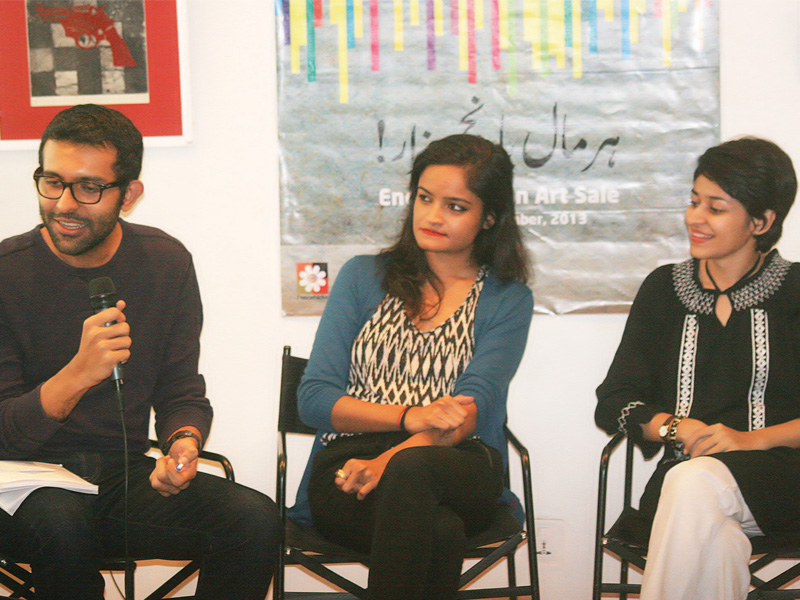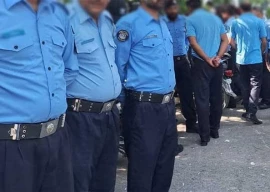
At a discussion on Right to the City: Travel Guide to Karachi on Sunday, its editor Shahana Rajani tried to explain this unique fact about Karachi when an audience member asked what kind of an image of Karachi did they portray in the book. A wry smile crossed Rajani’s face before she answered. “Karachi has no one face, it has an infinite number of faces and we have tried to portray a few.”
A city that can morph into an infinite number of faces cannot have a better adjective to describe it than ‘faceless’. In Right to the City: Travel Guide to Karachi, six young artists try to capture their own perspectives of the city and what it represents.

Skimming through the pages of the book, it is clear to see that this is not your average travel guide. In fact, it is not even a travel guide. It is a satirical take on Karachi’s beauty and its inelegance that is cleverly disguised in the format of a travel guide. “We only included the top attraction pages to deceive the reader into thinking, albeit fleetingly, that this was indeed just a regular travel guide,” revealed Rajani. “This book just uses the format of a travel guide.”
The first chapter is inspired by one of the earliest post-independence songs of Pakistan ‘Bandar Road se Keamari’ where Sara Khan travels through the historic route on a ghora gari (horse cart) as sung in the song. Khan said her fascination was drawn from the fact that the route still defiantly flaunts its colonial roots, one of the last standing memories of a colonial Karachi — of an activist and rebellious Karachi.
Manizhe Ali also focused on MA Jinnah Road, the old ‘Bunder Road’. She talked about how the road represents Karachi and its diversity. Ali was inspired by how the road sees the annual Ashura procession while also hosting the Yaum-e-Umar (RA). The road is a focal point of sectarian tension in the city and yet, Ali pointed out, in the evening Shias and Sunnis, Pathans and Muhajirs sit side by side at the local dhaaba at Numaish and sip tea together. “Hum aik nahi hain (We are not one),” Ali said passionately, her voice rising. “Hum alag hain, is hi main hamari khubsurti hai (we are different and that is where our beauty lies).”
Meanwhile, Shayan Rajani drew an interesting parallel between Sir Syed Ahmed Khan’s Delhi and modern day Karachi. He argued that 9/11, just like the 1857 war, has left an anti-Muslim bias in the Western world. He drew upon Sir Syed’s ‘Apni madad aap’ (help yourself) philosophy and said we must do something about it ourselves. Shayan does a brilliant job of hiding a serious and grave message behind satire without losing its meaning.
Perhaps the most interesting chapter of them all is Seher Naveed’s, who makes a map of ‘safe’ sites in Karachi. She highlighted the violence prone areas in Karachi and made a mirror image of the map, hence showing the areas that had the least number of violence. Unfortunately, and perhaps a little amusingly, most of the safe sites fell into the Arabian Sea. Karachi is safest where it ends, she smiled.
The city is indeed all that the book portrays it to be - an unsafe Karachi, a diverse Karachi, a historical Karachi and even a musical Karachi. Take one wrong turn or flip a few pages too many and you will find yourself looking at a different face of the city. No tourist should buy this book. Everyone in Karachi, however, should.
Published in The Express Tribune, December 10th, 2013.
COMMENTS (6)
Comments are moderated and generally will be posted if they are on-topic and not abusive.
For more information, please see our Comments FAQ

1722586547-0/Untitled-design-(73)1722586547-0-165x106.webp)


1732326457-0/prime-(1)1732326457-0-165x106.webp)


1732012115-0/Untitled-design-(14)1732012115-0-270x192.webp)









Where can I get a copy?
Just placed an order for 2 reasons
1) Love of Karachi 2) Support this book
Thank you guys !! I love the city , ain't no city like this in the world !
Karachi....the most diverse, cultured and beautiful city of Pak....
Karachi: A city of diversity.
Salute to every one who owns, loves, and cares about this city.
20 million people, 40 million faces